Subject: Dr. Ian Tizard, distinguished professor of immunology, director of the Schubot Exotic Bird Health Center and holder of the Richard M. Schubot Chair in Avian Health.
Education: Ph.D. Immunology, University of Cambridge, England (1969); B.Sc. Pathology, University of Edinburgh, Scotland, UK (1966); B.V.M. & S. Veterinary Medicine, University of Edinburgh, Scotland, UK (1965); Honorary D.Sc. Immunology, University of Guelph, Canada (2012).
Research Interests: Immunology with an emphasis on vaccine technology, avian viral diseases and whole avian genomes.
What is Proventricular Dilation Disease (PDD)?
PDD is a lethal viral disease that predominantly affects captive parrots, resulting in blindness, heart failure, brain damage or intestinal blockage. Caused by a strain of the avian Bornavirus, we believe birds obtain the virus from the droppings or urine of other birds or from their mothers. The virus that causes PDD can remain dormant for 10 to 15 years, meaning that birds may carry it but never show symptoms. PDD is the number one killer of big and valuable birds like macaws.
How do we combat it?
We developed and patented the first vaccine against PDD. Subsequent studies showed that birds who were given the vaccine did not develop PDD after being infected with a strain of Bornavirus, but we are awaiting USDA licensure before commercially manufacturing the vaccine. We are also working on a patent for a PDD diagnostic test that will enable veterinarians to diagnose the infection in real-time while examining a bird.
Why are bird genomics important?
Genomics help us understand the relationships between bird species. We are investigating the genomes of many species of green macaws and were the first to sequence the genome of the scarlet macaw. Genomics also reveal basic biological traits about birds. For example, scarlet macaws have genes for life span similar to those in humans; penguins don’t have any smell receptors in their brains, while chickens have more than 250; and parrots can speak because they have genes associated with speech development in humans.
Who lives in Texas A&M’s aviary?
Our aviary houses 270 birds. We have healthy monk parakeets, breeding cockatiels, budgerigars and a token chicken. In our diseased aviary, we have two blue-throated macaws, scarlet and green macaws, African greys, zebra finch, cockatiels and quail. While we use our birds for genetic and disease studies, we also use them in training and handling exercises for students. Through positive reinforcement, our goal is that every bird learn to approach a caretaker for a stethoscope exam.
Let’s talk funding.
Our research is funded by an endowment from the late Richard Schubot, who made a significant donation in 1987 to name our former avian complex the Schubot Exotic Bird Health Center. This endowment supports many of our projects and funds grants for faculty and students who research avian health. While more student scholarships and fellowships are always welcome, we have major-gift opportunities to name the new aviary and to create an endowed chair in exotic and wild bird medicine. Additional support would further develop and manufacture the PDD vaccine, and a personal long-term vision is to build a bird rehabilitation center adjacent to the complex.
Why does avian research matter?
Birds are intrinsically important to the health of the environment, and they are marvelous companions. At Texas A&M, we are also positioned to research diseases that have the ability to spread from the avian world to the human world.
Constructing the Complex
Texas A&M opened a new 11,000-square-foot avian complex in August 2015. The $3.2 million facility includes a hospital and receiving area, a laboratory for infectious disease research, three isolation rooms and separate areas for infected and healthy birds.
Mark and Karen Myers made a significant donation to name the complex’s clinical lab in honor of Mark’s father, Carroll Myers, a champion breeder of English budgerigar parakeets. “We were thrilled to honor his passion. Parakeets create the ultimate challenge in breeding due to their size, parental characteristics, personalities and massive array of colors,” Mark said. “This facility further advances Texas A&M toward worldwide prestige in research and education in veterinary medicine.”
An anonymous donor funded The Bingo Healthy Bird Aviary within the complex.
Give to the aviary at give.am/SupportAviary.
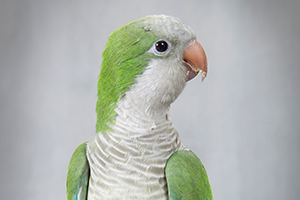
Fly the Coop
Originally from Belfast, Northern Ireland, Tizard came to Texas A&M in 1982. His interest in avian health sparked after seeing many new species of birds in North America and Texas.
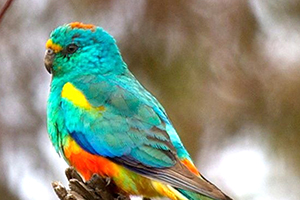
Eagle Eye
An avid bird watcher, Tizard travels the world to see birds in their native habitat. He’s seen most of the world’s penguin species and enjoys tropical trogons, but his favorite bird remains the scarlet macaw.
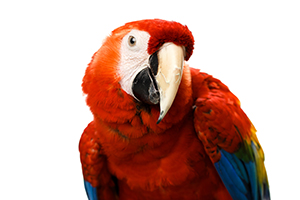
Take Flight
Under Tizard’s direction, avian researchers at Texas A&M work with the Texas Parks and Wildlife Department to increase the speed and effectiveness of response to birds endangered by oil spills. Researchers also collaborate on international projects in Peru, Canada, Argentina, Australia and Costa Rica.
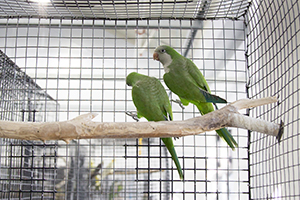
Leaving the Nest
Tizard and colleagues agreed to take in more than 100 monk parakeets that were abandoned after power companies tore down their nests for fear of electrical malfunction. The birds are undergoing a contraceptive study, and an adoption program is in the works for any offspring.
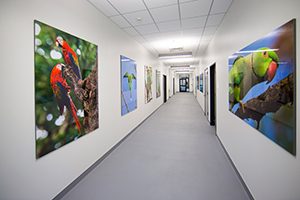
Colorful Feathers
The new avian complex is as colorful as its inhabitants. The building's walls feature illustrations of birds created by local middle and high school students, while a tabletop in the front lounge showcases a donated bird egg collection from 1900.